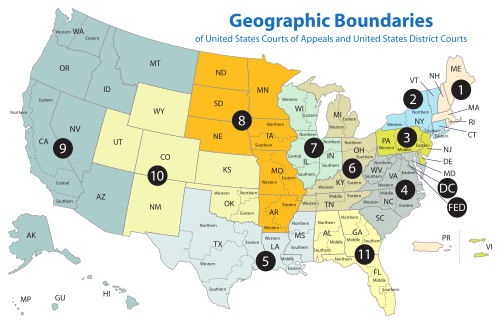
Article Three of the United States Constitution establishes the judicial branch of the U.S. federal government. Under Article Three, the judicial branch consists of the Supreme Court of the United States, as well as lower courts created by Congress. Article Three empowers the courts to handle cases or controversies arising under federal law, as well as other enumerated areas. Article Three also defines treason.

The United States district courts are the trial courts of the U.S. federal judiciary. There is one district court for each federal judicial district, which each cover one U.S. state or, in some cases, a portion of a state. Each district court has at least one courthouse, and many districts have more than one. District courts' decisions are appealed to the U.S. court of appeals for the circuit in which they reside, except for certain specialized cases that are appealed to the U.S. Court of Appeals for the Federal Circuit or directly to the U.S. Supreme Court.

The United States District Court for the District of South Carolina is the federal district court whose jurisdiction is the state of South Carolina. Court is held in the cities of Aiken, Anderson, Beaufort, Charleston, Columbia, Florence, Greenville, and Spartanburg.
Criminal jurisdiction is a term used in constitutional law and public law to describe the power of courts to hear a case brought by a state accusing a defendant of the commission of a crime. It is relevant in three distinct situations:
- to regulate the relationship between states, or between one state and another;
- where the nation is a federation, to regulate the relationship between the federal courts and the domestic courts of those states comprising the federation; and
- where a state only has, to a greater or lesser extent, a single and unified system of law, it is the law of criminal procedure to regulate what cases each classification of court within the judicial system shall adjudicate upon. People must be tried in the same state the crime is committed.
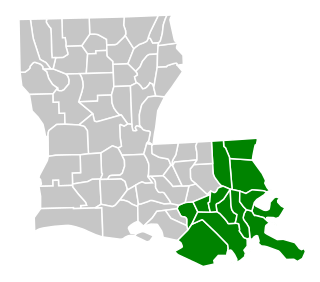
The United States District Court for the Eastern District of Louisiana is a United States federal court based in New Orleans.
The Judiciary Act of 1869, formally An Act to amend the Judicial System of the United States and sometimes called the Circuit Judges Act of 1869, provided that the Supreme Court of the United States would consist of the chief justice of the United States and eight associate justices, established separate judgeships for the U.S. circuit courts, and for the first time included a provision allowing federal judges to retire without losing their salary. This is the most recent legislation altering the size of the Supreme Court. The Act was signed by President Ulysses S. Grant.
In criminal law, a conspiracy is an agreement between two or more persons to commit a crime at some time in the future. Criminal law in some countries or for some conspiracies may require that at least one overt act be undertaken in furtherance of that agreement, to constitute an offense. There is no limit to the number participating in the conspiracy and, in most countries, the plan itself is the crime, so there is no requirement that any steps have been taken to put the plan into effect. For the purposes of concurrence, the actus reus is a continuing one and parties may join the plot later and incur joint liability and conspiracy can be charged where the co-conspirators have been acquitted or cannot be traced. Finally, repentance by one or more parties does not affect liability but may reduce their sentence.
In law, the venue is the location where a case is heard.
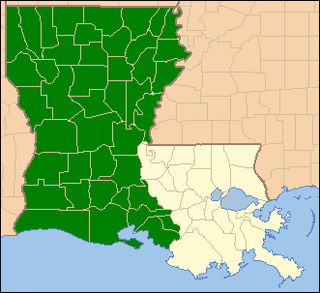
The United States District Court for the Western District of Louisiana is a United States federal court with jurisdiction over approximately two thirds of the state of Louisiana, with courts in Alexandria, Lafayette, Lake Charles, Monroe, and Shreveport. These cities comprise the Western District of Louisiana.

The United States Court for the Middle District of Louisiana comprises the parishes of Ascension, East Baton Rouge, East Feliciana, Iberville, Livingston, Pointe Coupee, St. Helena, West Baton Rouge, and West Feliciana. Court is held at the Russell B. Long United States Courthouse in Baton Rouge, Louisiana. It falls under the jurisdiction of the United States Court of Appeals for the Fifth Circuit.

The United States District Court for the Southern District of Iowa has jurisdiction over forty-seven of Iowa's ninety-nine counties. It is subject to the Eighth Circuit Court of Appeals.
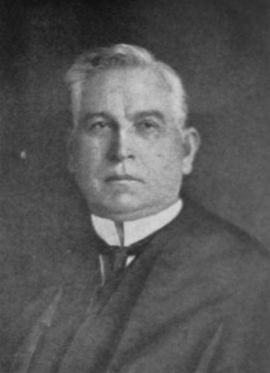
Joseph Travis Johnson was a United States representative from South Carolina and a United States district judge of the United States District Court for the Western District of South Carolina.
United States v. Johnson, 383 U.S. 169 (1966), is a United States Supreme Court case.
The Vicinage Clause is a provision in the Sixth Amendment to the United States Constitution regulating the vicinity from which a jury pool may be selected. The clause says that the accused shall be entitled to an "impartial jury of the State and district wherein the crime shall have been committed, which district shall have been previously ascertained by law". The Vicinage Clause limits the vicinity of criminal jury selection to both the state and the federal judicial district where the crime has been committed. This is distinct from the venue provision of Article Three of the United States Constitution, which regulates the location of the actual trial.

The Marshall Court (1801–1835) heard forty-one criminal law cases, slightly more than one per year. Among such cases are United States v. Simms (1803), United States v. More (1805), Ex parte Bollman (1807), United States v. Hudson (1812), Cohens v. Virginia (1821), United States v. Perez (1824), Worcester v. Georgia (1832), and United States v. Wilson (1833).
United States v. More, 7 U.S. 159 (1805), was a United States Supreme Court case in which the Court held that it had no jurisdiction to hear appeals from criminal cases in the circuit courts by writs of error. Relying on the Exceptions Clause, More held that Congress's enumerated grants of appellate jurisdiction to the Court operated as an exercise of Congress's power to eliminate all other forms of appellate jurisdiction.

The Taney Court heard thirty criminal law cases, approximately one per year. Notable cases include Prigg v. Pennsylvania (1842), United States v. Rogers (1846), Ableman v. Booth (1858), Ex parte Vallandigham (1861), and United States v. Jackalow (1862).

The Crimes Act of 1790, formally titled An Act for the Punishment of Certain Crimes Against the United States, defined some of the first federal crimes in the United States and expanded on the criminal procedure provisions of the Judiciary Act of 1789. The Crimes Act was a "comprehensive statute defining an impressive variety of federal crimes".
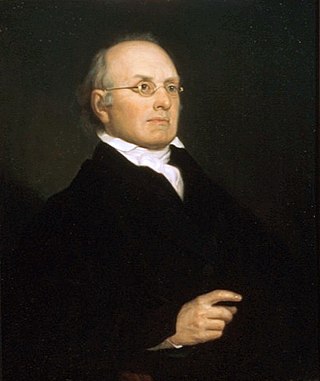
The Crimes Act of 1825, formally titled An Act more effectually to provide for the punishment of certain crimes against the United States, and for other purposes, was the first piece of omnibus federal criminal legislation since the Crimes Act of 1790. In general, the 1825 act provided more punishment than the 1790 act. The maximum authorized sentence of imprisonment was increased from 7 to 10 years; the maximum fine from $5,000 to $10,000. But, the punishments of stripes and pillory were not provided for.














